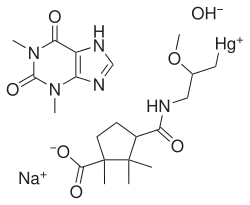Mercurophylline
 | |
| Names | |
|---|---|
IUPAC names
| |
Other names
| |
| Identifiers | |
CAS Number |
|
3D model (JSmol) |
|
| ChemSpider | |
PubChem CID |
|
InChI
| |
SMILES
| |
| Properties | |
Chemical formula |
C21H32HgN5NaO7 |
| Molar mass | 690.097 g·mol−1 |
| Appearance | Solid |
| Hazards | |
| Occupational safety and health (OHS/OSH): | |
Main hazards |
Mercury poisoning |
Except where otherwise noted, data are given for materials in their standard state (at 25 °C [77 °F], 100 kPa).
Infobox references | |
Mercurophylline is a mercurial diuretic, having the form of white or yellow odorless powder under room temperature.[1] It was formerly used as medicine, administered through injection or tablets.[2]
Mercurophyllin is poisonous when administered subcutaneously, intraperitoneally and intravenously. When administered intravenously, it can cause cardiac arrhythmia.[3] Prolonged oral administration can lead to gastrointestinal irritation and kidney damage.[4]
References
- ↑ Hospital Corpsman 3: A Course in Ten Parts with Test Material and Instruction Tests. Bureau of Naval Personnel. 1955. p. 451.
- ↑ National Formulary. American Pharmaceutical Association. 1970. p. LVII.
- ↑ PubChem. "Mercurophylline [INN:BAN:NF]". pubchem.ncbi.nlm.nih.gov. Retrieved 2023-06-26.
- ↑ Association), Council on Drugs (American Medical (1955). New and Nonofficial Remedies. Lippincott. p. 384.
This article is issued from Offline. The text is licensed under Creative Commons - Attribution - Sharealike. Additional terms may apply for the media files.